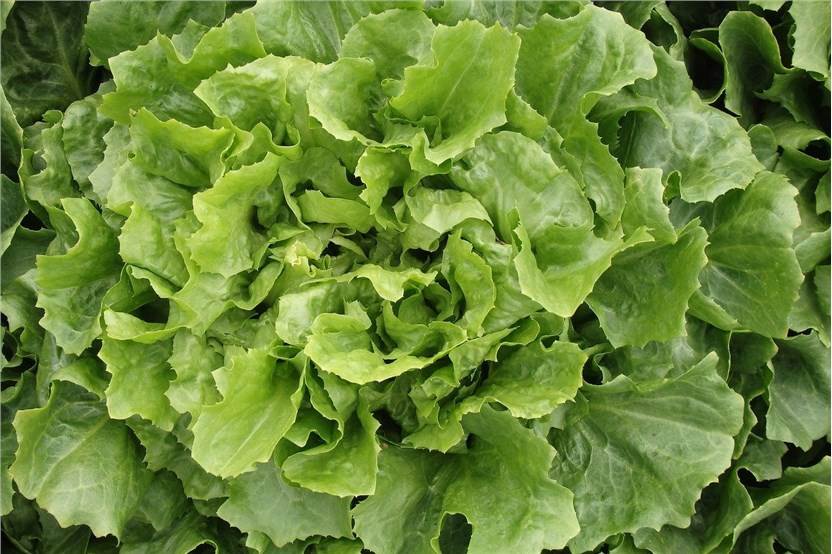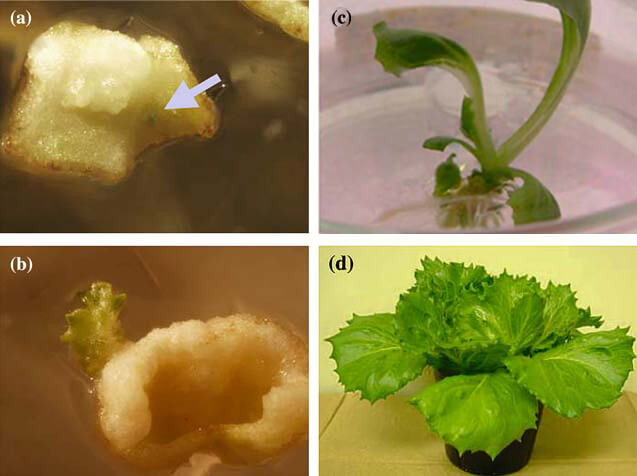Lactuca sativa Linn., also known as Lettuce , is one of the most important vegetable crops in the world. It belongs to the Asteraceae family, annual or biennial vegetation. It is edible, delicious, and has a crisp taste. At the same time, it can also stimulate the secretion of digestive enzymes, increase appetite, promote the peristalsis of the human intestinal wall, and prevent constipation. There are rich genetic variations among different cultivation types of lettuce, resulting in rich phenotypic differences. In recent years, researches on lettuce gene modification have continued to emerge, including speeding up the seed germination process, changing the color of leaves, and improving disease resistance, insect resistance, herbicide resistance, salt tolerance, cold tolerance, storage tolerance, fruit flavor, lycopene yield, etc.

Lifeasible provides one-stop services, covering all steps from experimental design, vector construction, plasmid transformation, positive transplant screening to characterization of transgenic Lactuca sativa Linn. We offer Lactuca sativa Linn. transformation using various genetic engineering technologies as follows:
Through the quantitative overexpression of genes related to lycopene, anthocyanin, malic acid and other chemical components in Lactuca sativa Linn., the production of specific compounds can be increased. We could help you overexpress many enzymes expression related genes like lettuce heading control genes (QTL, LsDRL1, LHL5), anthocyanin expression genes (CHS, CHI, F3H, F3’H, F3’5’H, DFR, ANS, 3GT), genes that control shattering of Lactuca sativa Linn., and many other genes related to important traits of Lactuca sativa Linn.
RNAi could induce specific mRNA degradation using homologous double-stranded RNA (dsRNA), then silence specific gene. Through RNAi technology, the silencing of multiple genes in Lactuca sativa Linn. can be mediated.
The VIGS technology is a transient transformation method which uses viruses carrying target gene fragments to silence endogenous genes of target plant. The silencing of some genes may lead to phenotype change, providing information for study of gene function. Due to the short period, VIGS can help you get valuable information for gene functional analysis fastly. With wealth of experience in VIGS, the scientists in Lifeasible provides you customized protocol for VIGS in Lactuca sativa Linn.We could achieve the transformation for Lactuca sativa Linn. with different genetic backgrounds.
The discovery of the CRISPR/Cas9 system provides us with a very powerful and convenient gene editing tool. By using CRISPR technology, we can achieve knockout of Lactuca sativa Linn. genes in different ways, including frameshift mutations, multiple deletion of fragments, knockout of non-coding genes, knockout of multiple copies of genes, etc.
Using the powerful scalability of the CRISPR system, we have developed many methods that can improve gene knock-in efficiency and achieve precise editing of the Lactuca sativa Linn. genome. Though NHEJ and HDR may occur at the same time due to DNA breaks, however, most of CRISPR gene knock-in is done through HDR. Therefore, we have developed different methods to increase the probability of HDR, thereby improving the efficiency of gene knock-in. Besides, prime editing, a technology could realize any type of base substitution is available at Lifeasible.
Through CBE and ABE, we could help you achieve the conversion from C to T or A to G in Lactuca sativa Linn. without DNA double strand break. During single base editing, the C base deaminase or A base deaminase is located at a specific position in the genome, and it catalyzes the deamination reaction of C or A at a specific position and turns it into U or I. Then it is treated as T or G in the process of DNA replication, realizing the conversion from C to T or A to G.
With the development of CRISPR/Cas9 technology, modifications of the CRISPR system have endow them with more utility function, one of them is CRISPRi technology. CRISPRi technology can inhibit the transcription of designated targets, whether it is coding or non-coding DNA fragments. CRISPRi uses catalytically inactivated Cas9 (dCas9). dCas9 can reach the designated site of the guide RNA. When dCas9 binds to the genome, it will block the binding of the transcription machinery and prevent this process from proceeding. For the inhibition of Lactuca sativa Linn. genes, we can provide a variety of solutions, including dCas9 binding to targeted DNA and realizing Inhibition of gene transcription through steric hindrance. In addition, gene knockdown can also be achieved by recruiting a fusion protein to the start site of gene transcription.
CRISPRa technology is very suitable for enhancing the expression of specific genes or analyzing the function of specific genes. For Lactuca sativa Linn. genes, we provide VPR technology, SAM technology and Suntag technology to make CRISPR system carry more activation element and achieve stronger activation effect after synergistic amplification.
Genetic screening system based on CRISPR technology can complete very low-cost mutation library construction work. The gene mutation library construction technology we provide for Lactuca sativa Linn. including gene knockdown library construction, gene knockout library construction, and gene activation library construction. Moreover, single-cell sequencing is available for mutation screening.
DNA-free gene editing has received extensive attention in recent years. It can effectively prevent genetic pollution and gene transfer, and has high biological safety. We provide DNA free Lactuca sativa Linn. genome editing services, including heterochromosomal gene editing, transient expression of CRISPR/Cas9 plasmid DNA, in vitro transcription of CRISPR/Cas9, and pre-assembled ribonucleic acid composed of purified Cas9 protein and sgRNAs complex. These technologies can avoid the integration of foreign DNA and genome, and reduce off-target effects. In addition, compared with traditional techniques, these techniques can avoid the use of hybridization or backcrossing to isolate CRISPR/Cas9 chimeras, so they are cheaper and have shorter experimental cycles.
So far, the most advanced and widely used method for the development of genetically modified Lactuca sativa Linn. is Agrobacterium-mediated. Briefly, the foreign target gene is transferred and integrated into plant cells through Agrobacterium, and then transformed plants are regenerated through techniques such as tissue culture.
 Figure 1. Agrobacterium-mediated Lactuca sativa Linn. transformation by infecting hypocotyl with Agrobacterium Transplastomic plants transformed with pRL1000. (a) Spectinomycin-resistant green callus indicated by arrow on selection plate. (b) Spectinomycin-resistant green shoot on selection plate. (c) Transplastomic lettuce plant with root on MS medium containing spectinomycin. (d) Transplastomic lettuce of the T1 generation grew normally on soil (Kanamoto H, et al. 2006)
Figure 1. Agrobacterium-mediated Lactuca sativa Linn. transformation by infecting hypocotyl with Agrobacterium Transplastomic plants transformed with pRL1000. (a) Spectinomycin-resistant green callus indicated by arrow on selection plate. (b) Spectinomycin-resistant green shoot on selection plate. (c) Transplastomic lettuce plant with root on MS medium containing spectinomycin. (d) Transplastomic lettuce of the T1 generation grew normally on soil (Kanamoto H, et al. 2006)
Lifeasible offers our customers with professional one-stop services, covering experimental design, vector construction, plasmid transformation, positive transplant screening and testing. Adapting to diverse purposes of different customers, multiple Agrobacterium strains (GV3111, LBA4404, GV3101, etc.), as well as commercial and customized binary vectors with variant selectable markers (Kanamycin, Hygromycin, Phosphinothricin, G418, etc.) are readily available for your use. Experts at Lifeasible obtain comprehensive knowledge and years of experience to solve technical problems and challenges in Lactuca sativa Linn. transformation. We can draw customized solution to help you research on a variety of Lactuca sativa Linn. genes (Including QTL, LsDRL1, LHL5 that play a key role in lettuce heading control, and CHS, CHI, F3H, F3’H, F3’5’H, DFR, ANS, 3GT that have a significant impact on anthocyanin expression, etc.), Our services guarantee the success of your project. For more information or any inquiry requirements, please contact Lifeasible.
Reference